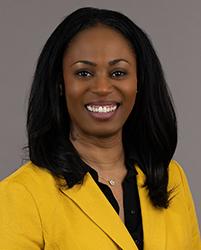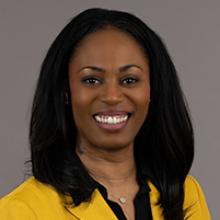Meet the Expert: Terris Ross

Terris Ross leads the AIR Equity Initiative’s education portfolio, with an emphasis on improving opportunities for communities segregated by race and place. In previous roles at the U.S. Department of Education, she designed and evaluated educational studies. In addition to her work at AIR, she is a member of the United Way of Greater Atlanta Gwinnett Advisory Board, which focuses on racial equity and healing initiatives across metropolitan Atlanta.
POSITION: Managing Director, AIR Equity Initiative
AREAS OF EXPERTISE: Education policy research, quantitative research methodology, K-12 accountability
YEARS OF EXPERIENCE: 15+
Q: What piqued your interest in this career in education equity?
Terris: It wasn’t a conscious decision, but I think it was rooted in my own lived experience as the only Black student in my advanced math and science courses. Mind you, I attended an elite magnet high school in a 90%+ Black community that was under court desegregation. It was jarring, because plenty of students in my community and my school looked like me, just not in my specific classrooms.
In graduate school, I fell in love with—believe it or not—item response theory, and in particular, differential item/bundle functioning. It’s a branch of psychometrics that essentially considers fairness in educational assessments. It allowed me to examine, through this technical lens, why students of equal ability may perform differently on certain test items; it allowed me to address bias in standardized testing, which has major implications for grade promotion and college admissions.
Q: Before graduate school, you worked as a high school mathematics teacher. How does that affect your educational equity work?
Terris: I was a teacher for only four years, but they were formative. When I conduct research, in the back of my mind, I’m always thinking about implementation. Researchers are sometimes guilty of saying, "Oh, here's something that'll work," without worrying about logistics and implementation. That, usually, is where things get messy! I think I’m aware of and sensitive to the demands on teachers’ time. Having been in those trenches, I try to consider the practical implications for all this theoretical work.
Q: You have evaluated many educational improvement programs. What common factors distinguish the effective ones?
Terris: I first want to ask—effective for whom, and under what conditions? For too long, we researchers have been obsessed with average treatment effects. We analyze programs based on whether they’re working for some “average” student, when there is no such thing. I’m excited that this is changing: more attention is being paid to powering studies to adequately detect moderator effects, like a student’s race or where they live or attend school.
Programs that use longitudinal data to follow participants over time, especially those that leverage administrative datasets, are better able to make a case for program effectiveness. The presence of large datasets allows evaluators to consider both direct and indirect effects. Beyond that, a program is only as effective as its implementation. What does an "effective" program, on paper, look like when the rubber hits the road?
Q: What drew you to the AIR Equity Initiative? Which accomplishments make you proud?
Terris: I was drawn to two things. The first was the opportunity to use my research skills to advance equity. I honestly love research and, as you can tell, I’m very passionate about equity, so that was a perfect marriage of my policy and practice interests.
The second was the opportunity to influence how research and technical assistance are applied to issues of segregation by race and place through the Equity Initiative’s grant-making mechanism. The Equity Initiative is AIR’s mission in action. We have more than 50 grantees, most—if not all—of whom are centering AIR’s standards for diversity, equity, and inclusion and cultural and linguistic competence in all aspects of their project work. When we fund projects within AIR, we enable our colleagues to focus on their equity passion projects, which is an incredible feeling.
I would be remiss if I didn't also mention the Pipeline Partnership Program, which elevates diverse voices and is diversifying the behavioral and social science research fields by supporting emerging scholars at Howard University; the University of Texas, San Antonio; and my alma mater, Georgia State University. We’ve also just expanded this program to two universities in East Africa—the University of Nairobi in Kenya and the University of Dar es Salaam in Tanzania.
Q: Over your time in the field, how have educational inequities in the U.S. evolved? What has remained constant?
We tend to want results quickly, so we don't really give interventions or strategies a chance to succeed before we start hunting for the next silver bullet.
Terris: In the last 20 years, a greater awareness has developed around how unequal the playing field really is for students. That has also brought a shift in the research community. We used to assume that we could just find the answers to inequity through our sophisticated statistical models. Now, new approaches focus on local context and actively involve those closest to the issues that we're trying to address.
Unfortunately, what has remained constant is our short attention span. We tend to want results quickly, so we don’t really give interventions or strategies a chance to succeed before we start hunting for the next silver bullet. But that’s human nature.
Q: What is the most widespread misconception about educational inequity?
Terris: People commonly mistake equity for the same thing as equality. Equality is the goal: that every child has the same opportunities to reach their full potential. Unfortunately, opportunities are so unevenly distributed that some children have a much greater likelihood of achieving that potential, while others have little chance at all. Everyone has their own definition of equity, but it begins with acknowledging that we’re not all starting from the same place. Equity requires systemic changes that remedy past injustices by shifting policies, practices, and beliefs. To do that, we have to provide marginalized communities with more resources than their privileged peers. Many people focus on equality of outcomes, but equalizing processes and practices is the first, necessary step.
Q: How do you see your work in education intersecting with other fundamental areas of inequity, such as health care, workforce, or housing?
Terris: At the Equity Initiative, we believe that for better and worse, education, health, workforce, housing, policing, and public safety are all interrelated and interdependent. We're challenging ourselves to stop considering them in silos and to promote a cross-sector approach to addressing these systemic inequities across systems.
I’m particularly excited about our Evidence and Demonstration Hub. We’re envisioning large-scale, place-based grantmaking, which will allow us to invest deeply in entire communities. The grantees might be school districts or community-based organizations and their focus would be education equity, but they would also be required to address at least one other sector. For example, maybe a school district is interested in addressing school integration in their community, but they also recognize that the policing of students is an issue. They would look at educational outcomes and planning academic interventions, but they’d tackle those in conjunction with policing issues.
Q: Where can we find you on a typical Saturday?
Terris: On Saturdays, my husband is in charge of our son, Jackson, so you can usually find me at brunch, eating southern fare with my twin sister. We live in the Atlanta metro area, so there’s no shortage of great restaurants!
Q: What book would you recommend to anyone?
Terris: Why We Can’t Wait by Martin Luther King, Jr., which includes “Letter from a Birmingham Jail.” Obviously, it’s not a new title, but I just read it recently, and it’s giving me so much energy around the Equity Initiative. Even though it’s almost 60 years old, many of his calls to action are still so relevant. It saddens me that some of the things he describes are still prevalent today, but it serves as a reminder that we still have more work to do.
